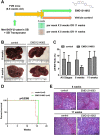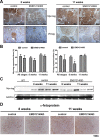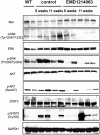The Effect of Selective c-MET Inhibitor on Hepatocellular Carcinoma in the MET-Active, β-Catenin-Mutated Mouse Model
- PMID: 29409568
- PMCID: PMC5954626
- DOI: 10.3727/105221618X15174108894682
The Effect of Selective c-MET Inhibitor on Hepatocellular Carcinoma in the MET-Active, β-Catenin-Mutated Mouse Model
Abstract
Simultaneous mutations in CTNNB1 and activation of c-MET occur in 9%-12.5% of patients with hepatocellular carcinoma (HCC). Coexpression of c-MET-V5 and mutant β-catenin-Myc in mouse liver by sleeping beauty transposon/transposase and hydrodynamic tail vein injection (SB-HTVI) led to the development of HCC with 70% molecular identity to the clinical subset. Using this model, we investigated the effect of EMD1214063, a highly selective c-MET inhibitor. Five weeks after SB-HTVI when tumors were established, EMD1214063 (10 mg/kg) was administered by gastric gavage as a single agent on 5-day-on/3-day-off schedule, compared to vehicle only control. Mice were harvested at 8 or 11 weeks posttreatment. Decreased p-MET, p-AKT, p-STAT3, and p-ERK proved in vivo efficacy of EMD1214063. We observed lower Ki-67, PCNA, V5-tag, and cyclin D1 after EMD1214063 treatment only at 8 weeks. Overall, no significant differences were observed in tumor burden between the groups, although EMD1214063 marginally but significantly improved overall survival by 1.5-2 weeks. Tumors remained α-fetoprotein+, did not show any differences in inflammation, and lacked fibrosis in either group. In conclusion, c-MET inhibition alone had a minor effect on Met-β-catenin HCC at the early stages of HCC development. Thus, a single therapy with the c-MET inhibitor will be insufficient for sustained response in Met-β-catenin HCC requiring assessment of additional combinations.
Conflict of interest statement
The authors declare no conflicts of interests.
Figures







Similar articles
-
Modeling a human hepatocellular carcinoma subset in mice through coexpression of met and point-mutant β-catenin.Hepatology. 2016 Nov;64(5):1587-1605. doi: 10.1002/hep.28601. Epub 2016 May 28. Hepatology. 2016. PMID: 27097116 Free PMC article.
-
The novel ATP-competitive inhibitor of the MET hepatocyte growth factor receptor EMD1214063 displays inhibitory activity against selected MET-mutated variants.Mol Cancer Ther. 2013 Nov;12(11):2415-24. doi: 10.1158/1535-7163.MCT-13-0151. Epub 2013 Sep 23. Mol Cancer Ther. 2013. PMID: 24061647
-
Dual inhibition of Akt and c-Met as a second-line therapy following acquired resistance to sorafenib in hepatocellular carcinoma cells.Mol Oncol. 2017 Mar;11(3):320-334. doi: 10.1002/1878-0261.12039. Epub 2017 Feb 17. Mol Oncol. 2017. PMID: 28164434 Free PMC article.
-
Recent developments of c-Met as a therapeutic target in hepatocellular carcinoma.Hepatology. 2018 Mar;67(3):1132-1149. doi: 10.1002/hep.29496. Epub 2018 Feb 1. Hepatology. 2018. PMID: 28862760 Free PMC article. Review.
-
Trends in the development of MET inhibitors for hepatocellular carcinoma.Future Oncol. 2016 May;12(10):1275-86. doi: 10.2217/fon.16.3. Epub 2016 Mar 17. Future Oncol. 2016. PMID: 26984595 Review.
Cited by
-
Targeting Wnt-β-Catenin Signaling Pathway for Hepatocellular Carcinoma Nanomedicine.Gastro Hep Adv. 2023 Jul 20;2(7):948-963. doi: 10.1016/j.gastha.2023.07.012. eCollection 2023. Gastro Hep Adv. 2023. PMID: 39130774 Free PMC article. Review.
-
LiverClear: A versatile protocol for mouse liver tissue clearing.STAR Protoc. 2022 Feb 15;3(1):101178. doi: 10.1016/j.xpro.2022.101178. eCollection 2022 Mar 18. STAR Protoc. 2022. PMID: 35243370 Free PMC article.
-
A Novel Transgenic Mouse Model Implicates Sirt2 as a Promoter of Hepatocellular Carcinoma.Int J Mol Sci. 2023 Aug 9;24(16):12618. doi: 10.3390/ijms241612618. Int J Mol Sci. 2023. PMID: 37628798 Free PMC article.
-
In Vivo and In Vitro Models of Hepatocellular Carcinoma: Current Strategies for Translational Modeling.Cancers (Basel). 2021 Nov 8;13(21):5583. doi: 10.3390/cancers13215583. Cancers (Basel). 2021. PMID: 34771745 Free PMC article. Review.
-
β-Catenin signaling in hepatocellular carcinoma.J Clin Invest. 2022 Feb 15;132(4):e154515. doi: 10.1172/JCI154515. J Clin Invest. 2022. PMID: 35166233 Free PMC article. Review.
References
-
- El-Serag HB. Hepatocellular carcinoma. N Engl J Med. 2011;365(12):1118–27. - PubMed
-
- Jemal A, Bray F, Center MM, Ferlay J, Ward E, Forman D. Global cancer statistics. CA Cancer J Clin. 2011;61(2):69–90. - PubMed
-
- 2017 Cancer stat facts: Liver and intrahepatic bile duct cancer. Available at https://seer.cancer.gov/statfacts/html/livibd.html
-
- Bruix J, Qin S, Merle P, Granito A, Huang YH, Bodoky G, Pracht M, Yokosuka O, Rosmorduc O, Breder V, Gerolami R, Masi G, Ross PJ, Song T, Bronowicki JP, Ollivier-Hourmand I, Kudo M, Cheng AL, Llovet JM, Finn RS, LeBerre MA, Baumhauer A, Meinhardt G, Han G; RESORCE Investigators. Regorafenib for patients with hepatocellular carcinoma who progressed on sorafenib treatment (RESORCE): A randomised, double-blind, placebo-controlled, phase 3 trial. Lancet 2017;389(10064):56–66. - PubMed
Publication types
MeSH terms
Substances
Grants and funding
LinkOut - more resources
Full Text Sources
Other Literature Sources
Medical
Research Materials
Miscellaneous
